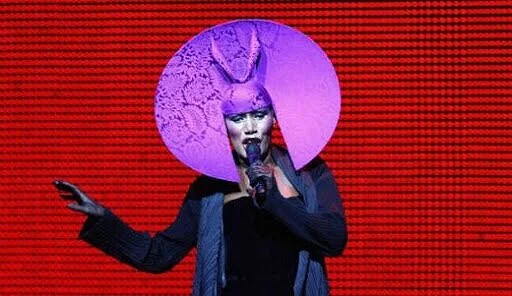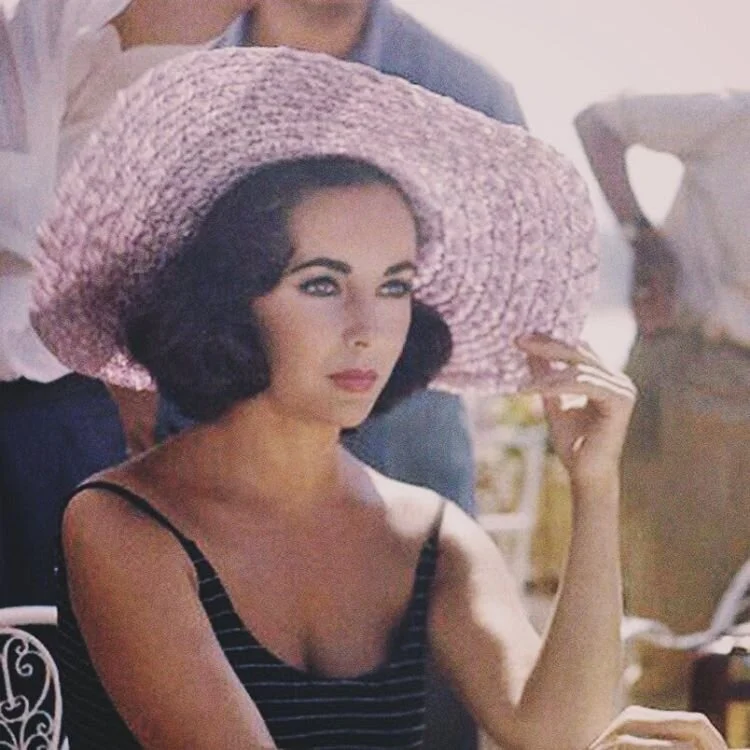By The Landlord
“Cock your hat – angles are attitudes.” – Frank Sinatra
“Everywhere you hang your hat is home. Home is the bright cave under the hat.” – Lance Morrow
“Hats are like a halo of happiness.” – An Na, Korean-American author.
“A crown is merely a hat that lets the rain in.” – Frederick the Great
"My sunglasses are like my guitar." – Patti Smith
“You cannot make a revolution with silk gloves." – Joseph Stalin
"The way you wear your hat. The way you sip your tea. The memory of all that – No, no! They can't take that away from me.” – Ira Gershwin
She climbed from the stage onto the shoulders of a huge security guy, wrapping her seemingly endless pins around his neck, bellowing: “This way boy!” He, turning from intimidating, brick shithouse-sized bouncer in black, to brick-shitting cowering-ass minion, suddenly looked terrified, and with good reason. All the time a spotlight bounced from her mirror-ball bowler, scattering light in all directions like scraps of fame to the adoring masses. So, forward she rode him, into the crowd, and then, at that moment, uncertain whether she might suddenly slap, punch, or even kiss me, I touched the gloved hand of the incomparable Miss Grace Jones.
Some people have a presence that requires no accessorising whatsoever, but some take what they’ve already got and multiply it. This particular occasion was in the early 2000s when Jones was on something of a comeback after several years of absence, bringing out her first album in years, at a small venue. She was almost an hour late on stage, but for each song she appeared with different headgear. Each headdress creation caused an increasing reaction of wowed adoration, but in typical mischievous fashion, Grace responded to this cooing and cheering with the wonderfully dry retort: “What’s wrong with you, people? It’s only a fucking hat.”
So then this week, let’s accessorise ourselves with songs about hats, gloves, scarves, sunglasses and the like, from a key lyrical moment to the song as whole, with items that variously signify fashion, function, status, class, profession, character or era, signifiers of the extrovert and introvert, echoes of the visual language of the animal kingdom, from threat to attraction.
Lady Gaga makes a point
Hats in particular, entirely independent from weather conditions, are as much as anything else a signal of history. There are times when everyone wears one and when almost no one does, from he pointy to the round, the flat to the tall, the military and magnificent, helmets to tricorns, stove pipes to flat caps, Easter bonnets to beekeepers nets, space helmets, African masks, cowboy hats, berets, busbys, bobble hats, covered in fruit or lights, fur or propellers, arrows, feathers or mirrors.
Grace Jones has always worn hats. She tells us: “You had to wear a hat to go to church. We weren't allowed to straighten our hair. We couldn't wear jewellery, nail polish, open backed shoes, skirts above the knee... trousers were forbidden because male apparel on a female was not godly.” So clearly that suppression led to a hunger to dress up even more. Jones of course has been the muse of leading milliner Philip Treacy, whose creations aren’t exactly the stuff of the average person in the street, but magnificent nevertheless.
As he puts it: “When people come and visit me and have a hat made, it's a little bit like visiting a psychiatrist, but they don't actually realise that. The personality of the wearer and the hat makes the hat.”
But when was the greatest era of the hat, Philip? “The classic hat image was during the forties and fifties, and Elizabeth Taylor was the epitome of that; she was the ultimate celebrity of excess and glamour, and she worked major sun hats.”
Liz Taylor. Days in the sun
Hats then certainly come and go. Everyone wore hats at the turn of the 20th century. They were perhaps as functional as fashionable, whatever shape, and if the series Peaky Blinders is at all a representation, the floppy cloth caps of post First World War had another function, containing razor blades in the brims in case of trouble.
Peaky Blinders
Actor John Malkovich is here too, a man who loves to cover his famous pate. "In New York in the forties or fifties, everybody's in a suit, an overcoat and a hat."
Fashion commentator Peter York then remarks a different trend in his favourite decade: “By the 1980s, practically no one under 60 in the real civilian world wore hats for anything except weddings, funerals or Ascot. Hats had been in competition with hair, and hair had won. Thirty years before that, Brits of all classes and ages wore hats all the time.”
The great Isambard Kingdom Brunel. A short man made taller by the stove pipe fashion of the 19th century
But hats seem to be back now as much as ever, with no particular trend dominating, unless you’re a politician such as Trump, peddling a false common man image with a baseball cap. So then, there’s a real sea of hats and other accessories now flooding into the Bar, with guests each to tell us more about what effect they have.
"Never try to wear a hat that has more character than you do,” adds the writer Lance Morrow. But Margaret Atwood says she can have many characters: “I myself have 12 hats and each one represents a different personality. Why just be yourself?”
“I don't use a hat as a prop. I use it as a part of me,” says fashion muse Isabella Blow.
But Carly Simon feels a conflict between herself and her accessories. “As a singer I tried on all these hats, these voices, these clothes, and eventually out came me."
“Well, I collect hats. That's what you do when you're bald,” says James Taylor.
A hat collection
Hats are something of an addictive head-covering, but then they also have peculiar long-term effects. “Have you noticed when you wear a hat for a long time it feels like it's not there anymore? And then when you take it off it feels like it's still there?” says George Carlin. True indeed.
Some people are never seen without hats. Wizards for instance. “Hat = wizard, wizard = hat. Everything else is frippery,” says Terry Pratchett.
Or indeed cowboys. The film director, who has certainly many characters in them, reckons these are nothing to do with fashion. “That cowboy look - the hat and the bandana - that's not a fashion statement. That clothing is purely practical.”
Bruce Beresford meanwhile has a different perspective on Mexican headgear. “Everyone has seen photographs of Mexicans wearing those big sombreros. When you come to Mexico, the astonishing thing is, nobody wears these hats at all."
A couple of authors are now in the house with their be-hatted perspectives. ““Some hats can only be worn if you're willing to be jaunty, to set them at an angle and to walk beneath them with a spring in your stride as if you're only a step away from dancing. They demand a lot of you.” Quotes Neil Gaiman from Anansi Boys.
“Wide brimmed and narrow, some tall, some not, some fancy, some colourful, some plaid, some plain. She doted on changing hats at every opportunity. When she met the Prince, she was wearing one hat, when he asked her for a stroll, she excused herself, shortly to return wearing another, equally flattering,” reads William Goldman from The Princess Bride.
Curvy
But what happens if you lose your hat? Is it a bit like losing your head? “There are very few moments in a man's existence when he experiences so much ludicrous distress, or meets with so little charitable commiseration, as when he is in pursuit of his own hat,” says Charles Dickens.
Perhaps losing a hat had something of an effect on Morrissey’s head when he was young, living in Stretford, Manchester, just down the road from Old Trafford. “I once bought a Manchester United hat, which I think was 12 shillings, and somebody ran up behind me and pulled it off and just ran ahead. I thought, 'It's a very cruel world, I'm not prepared for this'. And I decided to get my revenge on society." Hmm. Interesting psychology there.
Talking of disturbance as childhood, here’s Michael Jackson, with his explanation of how is accessories needed to be white (and perhaps more than just those). “I love to accent movement. The eye goes to where the white is - you know, the glove. And the feet, if you're dancing, you can put an exclamation point on your movement if it has a bit of light on it. So I wore the white socks. And for the design of the jacket, I would sit with the people who made the clothes and tell them where I wanted a button or a buckle or a design."
One of the great hat-wearing characters
To top off our hat section though, here are a couple of true poets taking them in bigger and simile and metaphor, to meteorological proportions:
"Expecting rain, the profile of a day Wears its soul like a hat." – John Ashbery
"Got a head full of lightning, a hat full of rain." – Tom Waits
Swiftly then, let’s slip on the other big music accessory, the sunglasses, with a few more guests.
“Always have sunglasses with you. They're great for when you can't be bothered to put make-up on,” advises Alison Goldfrapp.
“Well, hey, a man can never have too many pairs of sunglasses or too many guitars,” says Bon Jovi’s guitarist, Richie Sambora.
And here’s Jack Nicholson. "With my sunglasses on, I'm Jack Nicholson. Without them, I'm fat and 60."
So then, it’s time for you, learned readers to check your musical accessory cupboards for songs on this topic. Who then, will wear the sacred guru’s hat? Who will have an iron hand in a velvet glove, a phrase coined by Holy Roman Emperor Charles V, but also used to describe the great Matt Busby. This week’s bearer of the sacred crown, I’m delighted to say, is the returning marvellous Mnemosene2 . Please put your nominations in comments below in time for last orders at 11pm, UK time on Monday for playlists published on Wednesday. I’m sure it will all be a perfect fit.
Philip Treacy again. But will your ship come in this week?
New to comment? It is quick and easy. You just need to login to Disqus once. All is explained in About/FAQs ...
Fancy a turn behind the pumps at The Song Bar? Care to choose a playlist from songs nominated and write something about it? Then feel free to contact The Song Bar here, or try the usual email address. Also please follow us social media: Song Bar Twitter, Song Bar Facebook. Song Bar YouTube. Subscribe, follow and share.









